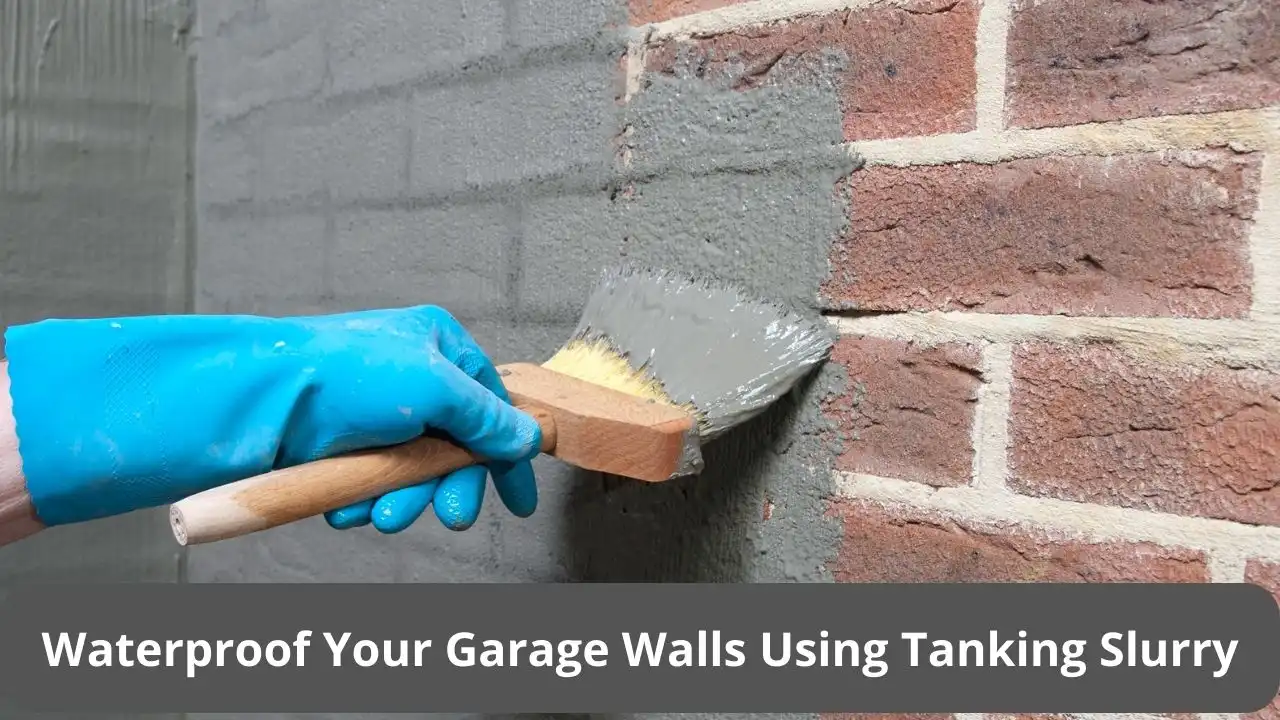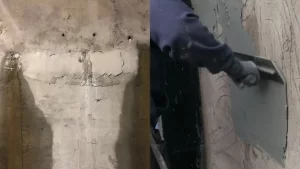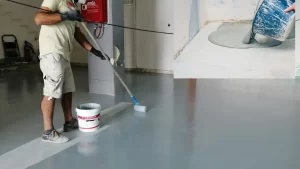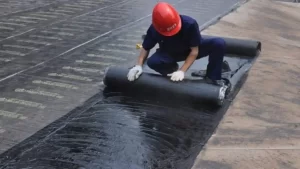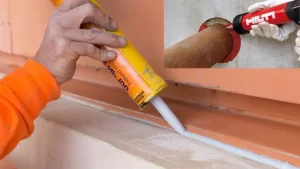What exactly is waterproofing and why do you need it? Waterproofing is a process that involves applying a coating to a surface in order to prevent water from penetrating it. This is important for any number of reasons, but especially if you live in an area with high rainfall or flooding.
When it rains, water can often seep through cracks in your garage wall and cause damp patches to form. This is not only unsightly, but it can also lead to serious structural damage if left unchecked.
One way to waterproof your garage wall is to use tanking slurry. Tanking slurry is a thick, viscous liquid that is applied to the surface of your garage wall. It forms a waterproof barrier that prevents water from seeping through cracks and causing damp patches.
What is the Tanking Slurry and How Does it Work?
Tanking slurry is a viscous, clay-based material used to coat the interior of reservoirs, sumps and other water-containing structures. It is designed to stop or significantly reduce water ingress through porous concrete or masonry walls.
Tanking slurry is an effective barrier to water and may be employed in conjunction with a sump pump to remove any water that penetrates through. Slurry is most commonly used in basements, cellars and other areas where water ingress is a problem. It can also be used to coat the inside of water tanks and reservoirs.
You can apply it to a structure by brush or roller and left to dry. Once dry, it forms a hard, impermeable barrier that is highly effective at stopping water ingress.
If you are experiencing problems with water ingress in your home or business, tanking slurry may be the solution you are looking for. Contact a professional waterproofing contractor to discuss your options and find out if tanking slurry is right for you.
Items you need:
To apply tanking slurry, you will need:
- A bucket
- A trowel
- A brush
- Tanking slurry
Instructions:
1. Prepare the wall surface
Before you can apply tanking slurry, you need to prepare the surface of your garage wall. Start by cleaning the wall with a brush or power washer. This will remove any dirt, dust or debris that could prevent the tanking slurry from adhering to the wall.
If there are any cracks in the wall, fill them with a concrete repair compound. This will provide a smooth, even surface for the tanking slurry to adhere to.
2. Mix the tanking slurry
Once the wall is clean and any cracks have been filled, it’s time to mix the tanking slurry. Follow the instructions on the packaging to ensure you mix the correct ratio of water to tanking slurry. Mixing too much water will make the slurry less effective, while too little water will make it difficult to apply. Beware that tanking slurry can be messy, so mix it in a well-ventilated area.
3. Apply the tanking slurry
Once the tanking slurry is mixed, use a trowel to apply it to the surface of your garage wall. Start at the bottom of the wall and work your way up in small sections. Apply a thick layer of tanking slurry, making sure to fill any cracks or crevices. Use a brush to smooth out the slurry and create an even surface.
4. Allow the slurry to dry
Once you’ve applied the tanking slurry, allow it to dry for 24-48 hours. During this time, the slurry will harden and form a waterproof barrier. Once it’s dry, your garage wall should be protected from water damage. You should reapply the tanking slurry every few years to ensure maximum protection.
5. Enjoy your weatherproofed garage
By following these steps, you can easily weatherproof your garage wall using tanking slurry. This simple project will help keep your garage dry and free from damp patches, preventing any structural damage.
When applied correctly, tanking slurry creates a waterproof barrier that is highly effective at stopping or reducing water ingress. However, it is important to note that tanking slurry is not a permanent solution and will need to be reapplied periodically in order to maintain its effectiveness.
Four Ways to Keep Your Garage Waterproof on a Budget:
The majority of homes built from wood and concrete have the disadvantage that they lack waterproofing. The cost to install it may be prohibitive for some homeowners, but there are a plethora of options that will not break the bank.
You can avail any of these four options to waterproof your garage walls when it is made of wood:
Crystalline concrete agent:
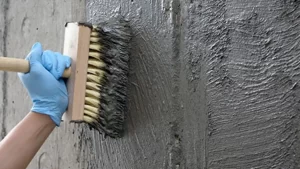
Once the concrete has been treated with a crystalline concrete waterproofing agent, it is textured to look like stone. This type of waterproofing is ideal for homes in areas that receive a lot of rain or are prone to flooding. You may be wondering how a crystalline concrete waterproofing agent works?
The agent contains chemicals that react with the calcium hydroxide in the concrete to create crystals. These crystals fill the pores of the concrete and act as a barrier to water. The crystalline concrete waterproofing agent also reacts with the silica in the concrete to create a water-resistant surface.
Waterproof paint or epoxy:
Waterproof paint or epoxy is a type of coating that can also be used on walls, floors, and ceilings in homes and businesses. These products work by creating a barrier between the surface and the water. This barrier helps to prevent water from seeping into the surface, which can cause cracks, mold growth, and other damage.
Once the waterproof paint or epoxy has been applied, it will need to be allowed to dry completely before the area can be used. This type of waterproofing is ideal for areas that are not prone to flooding but may experience occasional moisture. These products are available in a variety of colors, so you can choose the one that best matches your home’s décor.
Waterproofing membrane:
A waterproofing membrane is a thin layer of water-resistant or waterproof material that is applied to the surface of an object to prevent water damage. Waterproofing membranes are often used on roofs, decks, and other exposed areas where water can seep in and cause problems.
When choosing a waterproofing membrane, it is important to select one that is compatible with the surface you are applying it to. For example, if you are applying a waterproofing membrane to concrete, you would need to choose a product that is designed for use on concrete.
The application of a waterproofing membrane is typically done by a professional, but there are some products that can be applied by the homeowner. This type of waterproofing is ideal for areas that are prone to flooding or receive a lot of moisture.
Sealant:
A sealant is a material that is used to fill in gaps and cracks in surfaces. Sealants are commonly used in construction and home improvement projects, as they can provide a water-tight seal that prevents moisture and other materials from seeping through cracks and gaps.
Some sealants are designed for specific applications, such as sealing tubs and showers, while others can be used for a variety of purposes. When selecting a sealant, it is important to choose one that is compatible with the material you are sealing.
For example, latex sealants are not recommended for use on ceramic or glass surfaces. In addition, some sealants require the use of a primer before they can be applied, while others do not. Once you have selected the appropriate sealant for your project, follow the manufacturer’s instructions for best results.
Frequently Asked Questions:
How do you waterproof a concrete garage wall?
One way to waterproof a concrete garage wall is to apply a sealant. This will help to protect the concrete from water damage and staining. There are a variety of sealants available on the market, so be sure to choose one that is appropriate for your specific needs.
How do you waterproof the bottom of drywall in a garage?
There are a few ways to waterproof the bottom of drywall in a garage, but the most effective method is to use waterproofing paint. This type of paint can be applied to the bottom of the drywall and will create a seal that will prevent water from seeping through.
How do you seal the bottom of a garage wall?
The best way to seal the bottom of a garage wall is to use a waterproofing sealant. This will help to prevent water from seeping into the garage and causing damage. You can apply the sealant with a brush or roller, and it is important to make sure that you follow the manufacturer’s instructions carefully.
Why is my garage flooding when it rains?
When it rains, water can quickly pool in your garage if there is nowhere for it to drain. This can happen even if your garage is equipped with a drainage system. If your garage floods when it rains, there are several possible reasons.
Why are my garage walls wet?
There are a few potential reasons why your garage walls might be wet. One possibility is that there is a leak in the roof or walls of the garage that is allowing water to seep in. Another possibility is that the humidity level in the garage is high, causing condensation to form on the walls.
What is the cheapest way to finish a garage wall?
There are a few different ways to finish a garage wall, but the cheapest way is probably to panel it. You can find panels at most hardware stores, and they’re relatively easy to install. Just make sure you measure the wall before you buy the panels so you know how many you’ll need.
How do I seal my garage foundation?
To seal your garage foundation, you will need to purchase a concrete sealer from your local hardware store. Apply the sealer to the entire surface of the foundation using a brush or roller. Allow the sealer to dry for 24 hours before painting or staining the foundation.
Final words:
And there you have it! Waterproofing your garage walls is a simple and effective way to keep your garage clean and dry. By following these simple steps, you can be sure that your garage will be protected from the elements for years to come. So don’t wait any longer, get started today!

